What to Wear at Fancy Halloween Parties
by M. Blankier
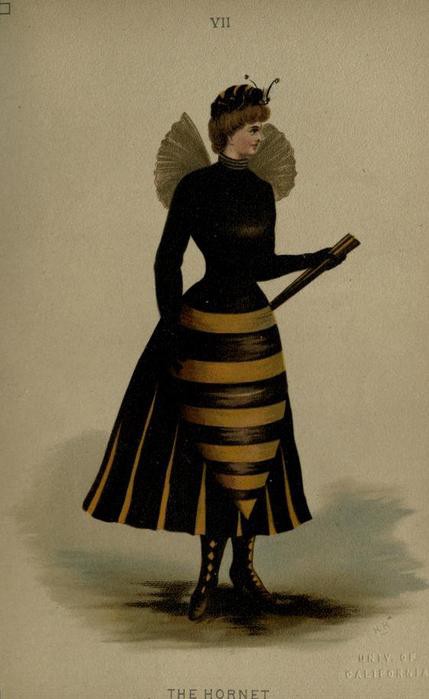
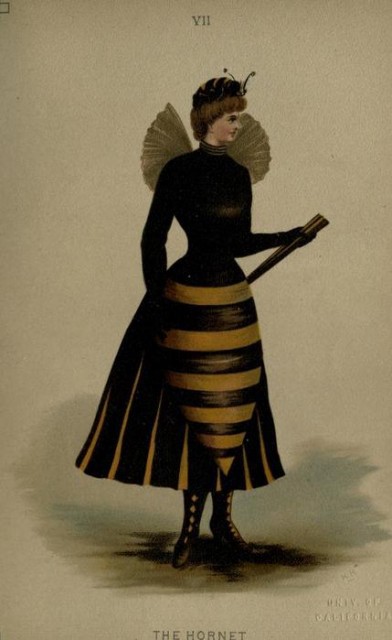
The sexy Halloween costume is tyranny; it is irony without attendance. Sexy Halloween costume, I decry you. This Halloween, I humbly submit that we take our costume cues from a simpler, less brazenly sexy time: Arden Holt’s Fancy Dresses Described; or, What to Wear at Fancy Balls, already through five editions in 1887. This volume has suggestions for everybody: “brunes,” fair women, history enthusiasts, elderly ladies, and even gentlemen. Here are some selections of fancy dresses:
(Please note: “to avoid glaring inconsistencies, it is well to remember that powder was introduced into England in James I.’s reign, though not very generally worn.”)
Aquarium: Fashionable evening dress of blue and green tulle, trimmed with marine plants and ornamented with fish and shells, the octopus on one side of the skirt; veil of green tulle; hair floating on shoulders. Bodice trimmed with seaweed and coral; ornaments, silver fish and coral.
Amsterdam Orphanage: Short plain full gathered skirt, one side black, the other red, the plain tight bodice similarly divided; white tucked apron; large kerchief worn over the dress, crossing in front; cap of thick white muslin, the front close-fitting in front; cap of thick white muslin, the front close-fitting and flat, the back full.
Bunch of Keys: A long black dress on which gilt paper keys are sewn at intervals. A bunch of keys are suspended at the waist. The head-dress, necklace, and earrings are made of gilt paper.
China, Wedgwood: Has a sort of cottage hat of blue and white with the Greek key bordering; a white under-bodice low and heart-shaped; a blue cuirass bodice over, with the same key pattern on white; tunic of blue and white bordered with a band of blue, and blue tassels; blue short skirt, a blue and white caladium leaf carried in the hand.
Dew: White tulle evening dress and veil studded with crystal drops; trimmings of green grass. Hair hanging loose, sprinkled with frosting powder; wreaths of grasses.
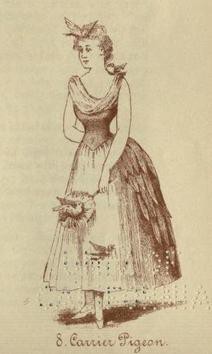
Diablesse: Red dress, with red cap and wings; carrying horned trident. Or, pale grey skirt with appliques of animals in red velvet; black gold-spangled scarf; grey bodice with black velvet bats appliqued on to front; red velvet hat with gold aigrette and red feather.
Five-O’Clock-Tea: Short white skirt embroidered with cups, saucers, and teapot; blue tunic and bodice, muslin fichu and apron, with dial of clock pointing at 5, embroidered teapot beneath; head-dress, a tea-cosy; silver chatelaine, with teaspoons and sugar-tongs; ornaments, silver spoons, and cups. Instead of embroidery, chintz cups and saucers may be gummed on. Long dress of soft terra-cotta silk, with belted heart-shaped bodice, long hanging sleeves, with saucers painted over them, small cap like a saucer, with aigrette of sugar-tongs; spoons round the neck.
Footwoman of the Future: Black satin quilted skirt; maroon double-breasted tail-coat, brass buttons; black waistcoat showing beneath the jacket in front, and lace ruffles; hair powdered; tricorn black and gold hat; gold-headed cane in hand.
Gold Mine: Dress of white and gold brocade or tulle, made as a fashionable evening dress, trimmed with sequins; a painted panel let into one side, with a sketch of a gold mine.
Grandmother, My Great, or the Ghost of My Grandmother: is generally rendered by a poudré dress of brocade, with large cap, sacque, fichu, quilted skirt, high heels, and stick; lace mittens. Another style is a black dress with folds of muslin crossing the bust, large cap, spectacles, and white curls. For the Ghost of my Grandmother it must be all in white. (Ms. Holt recommends this costume particularly to elderly ladies, without thought for the relevant temporal paradoxes and associated psychotic breaks such paradoxes may incite; I therefore recommend that only advanced costume-wearers embark on this enterprise.)
Oysters, Queen of: Dress of white tulle, studded with oyster-shells, coral, and seaweed; wreath of same round the low bodice.
Polyphemus, H.M.S.: Grey dress with badge of the ship in gold letters on bodice; wooden ornaments of torpedoes on one shoulder and in hair. This is suitable for nautical ball. (This is the H.M.S. Polyphemus of 1881; the H.M.S. Polyphemus of 1782 may require some adjustments.)

Sour Grapes: Maize sateen dress, covered with grapes cut out from chintz and appliquéd on; a muslin cap on the head with a bunch of grapes, and bunches of artificial grapes on the low square bodice and elbow-sleeves, and in the muslin apron turned up and forming a lap.
If appropriating another culture for your costume is more your style, Ms. Holt has provided instructions on how to dress like a peasant, shepherdess, maid, or water-bearer of the following nations and regions: Abruzzo, Arcadia, Austria, Basque, the Black Forest, Bulgaria, Burma, Castilia, Connaught, Denmark, Holland (Dutch fish wife), Friesland, Germany, Hungary, Ireland, Italy, Jutland, Lorraine, Madeira, Moravia, Normandy, Norway, Piedmont, Poland, the Rhineland, Rome, Russia, Sardinia, Styria, Swabia, Sweden, Switzerland, and Wurtemberg. Ms. Holt notes, however, that the peasantry you are attempting to portray may view such costumes with curiosity. Dressing up as an actual place, though, is a separate endeavor:
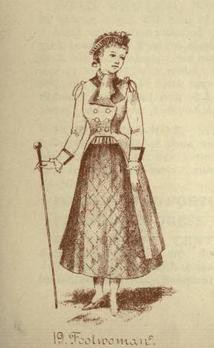
Canada: White skirt and white plush jacket, trimmed with puffings of silver tulle and cloth of silver; a blue scarf round hips, edged with silver sleigh-bells. The jacket braided and frogged with silver; wreath of maple leaves and rowan berries across bodies; blue scarf, caught up on shoulder with Canadian blue-bird. Blue cap after Scotch shape, trimmed with swansdown, embroidered with silver; hair powdered; blue satin muff, small bird at side. Insignias round waist: snowshoes, toboggans, canoe skates, and tobacco pouch. Or, a classic robe of white with a wreath of maple leaves round the bodice. Head-dress, maple wreath with hair flowing, or a helmet with maple leaves and effigy of Peace and the beaver. In left hand oval shield representing Union Jack, about 2 feet high, “Canada” inscribed in centre. Another rendering is the dress worn in the country, made of blanket flannel with many coloured striped border; epaulettes on shoulder of the stripes; bright crimson sash; a cap of dressed beaver skin.
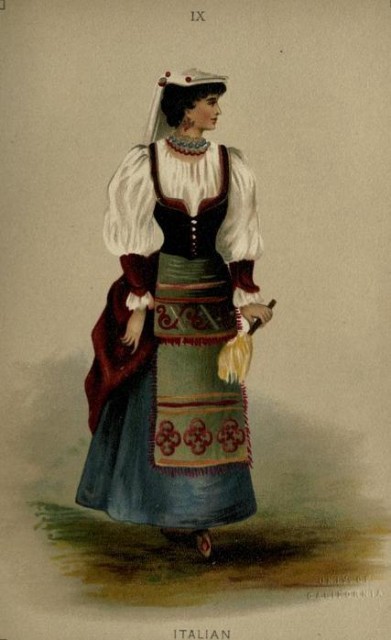
Canal, Suez: Long flowing robe of cloth-of-gold, with waves of blue satin bordered with pearls; under-skirt of red satin embroidered in Egyptian designs. A gold key at the girdle; Egyptian head-dress of pearls, turquoise, and diamonds; girdle of roses and lilies.
Europe: is generally carried out by the national dress of some European country, say Italy, Spain, or France. Or with a white cashmere classic robe, with a battlemented crown, bearing the names of the different countries. The ornaments on the dress are white bulls.
Many of these costumes can be repurposed for young children, but some specially-considered options include: Cupid, Garibaldi, fairy, Maltese water carrier, Hamlet, white cat, Puss in Boots, Irish car driver, and Welshman.
Remember Ms. Holt’s eternal words, “there are few occasions when a woman has a better opportunity of showing her charms to advantage than at a Fancy Ball.” A sexy devil, sexy cat, sexy Lincoln, or sexy pizza is not the best way to accomplish this — -instead, consider dressing as an elegant torpedo boat, fine china, the ghost of your grandmother, or a continent to show off your charms to best effect. Never again shall we ask, “But — what are we to wear?” A wreath of oyster shells is the answer.
Images courtesy of Fancy Dresses Described; or, What to Wear at Fancy Balls.
M. Blankier is a Ph.D candidate at Trinity College Dublin, and splits her time between Ireland and Toronto. Her writing has previously appeared on The Toast.